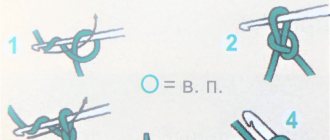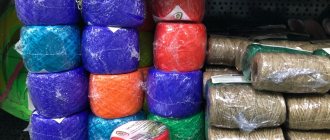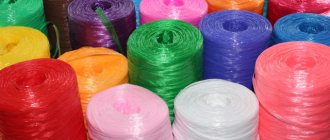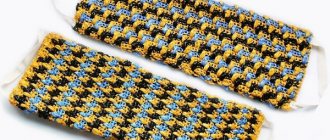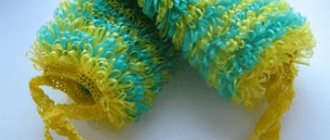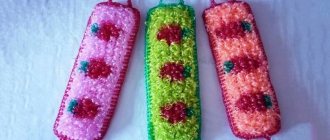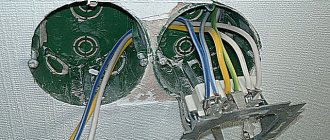Crochet Basics
For those who have already mastered them, scroll on. For those just starting to figure it out, here are some tips:
Air loop
Double crochet
Single crochet
Connecting post
Follow the links and watch the step-by-step description with video
- How to learn to crochet
- Adding and decreasing stitches with crochet. Long loops
Which yarn to choose for knitting a washcloth
There are no exact instructions here. Although specialized threads exist. These are sold in stores, but they cost from 200 rubles.
If you want to knit a “purchased” option, then go to a fixed price, they sell twisted thread for only 50 rubles. One skein is enough to knit a washcloth.
True, there is a nuance here: a ready-made washcloth with elongated loops is sold right there, only 5 rubles more expensive. Buy or knit yourself - it's up to you.
- A polypropylene thread is ideal (the one mentioned above). It is hard and synthetic. Dries quickly.
- Wool. It's always nice to use natural materials. You can even buy untreated thread, which is a little prickly - a scrub effect.
- Twine or jute thread. Rough, it is used for bath sponges.
- Plush yarn. Soft, pleasant to the body. Foams well.
- Yarn-grass. It will give volume and be just as soft and tender.
- Cotton. The most versatile fiber.
Any leftover yarn with any composition. Don’t think that a washcloth can only be knitted from a special material. Absolutely any yarn that is available will do. Here it is important to understand what is right for you: whether you want to wash with a synthetic washcloth or prefer natural fibers. But there is no difference in knitting.
Which yarn won't work?
Mohair, angora - all “fluffy” threads. To knit a washcloth, it is better to take non-fluffy yarn that will not deform if it comes into frequent contact with water.
How to choose threads
The best yarn for washcloths is single- or double-twisted polypropylene, but threads that are natural in composition are even more valued. The yarn should be strong and smooth. The thicker the thread, the stronger the product.
- Jute. Eco-friendly washcloths are knitted from it. Jute yarn is made from the fibers of an annual plant grown in India and Egypt. A jute washcloth is moderately hard, it absorbs water well and lathers up. Daily exposure of jute to the skin stimulates blood circulation and improves metabolic processes in the dermis.
- Hemp. Yarn made from hemp stem fibers. Its properties are similar to flax, but at the same time more durable and lighter. Products made from it do not lose their shape and do not stretch when exposed to moisture.
- Lyko. It is made from linden or willow wood fibers. These washcloths are suitable for sensitive skin.
- Loofah. Yarn made from grass fibers. Its effect on the skin is difficult to overestimate: pore cleansing, anti-cellulite massage, cell regeneration. At the same time, such a washcloth turns out to be very tough. The loofah holds its shape well, quickly soaks in water and lathers well.
- Sisal. Agave fiber. Like any natural yarn, it has a beneficial effect on the condition of the skin, but due to its increased rigidity, it is recommended to use this accessory no more than twice a week. The disadvantage of sisal is that it takes a long time to dry.
- Linen. The most delicate material, suitable for baby washcloths, but before use, such an accessory must be steamed with hot water.
- Cotton. Most often it is used for washcloths for babies. Such products are short-lived, but cotton is best suited for children's skin.
- Capron. Such threads are usually thin, so they are knitted in several layers. The products are durable, but tend to stretch.
- Polyethylene. For knitting, it is better to use industrially produced yarn, but experienced craftswomen can also indulge in creativity using homemade “threads” from ordinary plastic bags. The advantage of such washcloths is moderate rigidity and durability. The downside is poor absorption and the possibility of skin allergies.
Crochet washcloth with elongated loops
The most common knitting option. This model took one skein of yarn from the fixed price. There are different colors available.
Once you understand how elongated loops are knitted, you can knit any type of washcloth this way. That is, by applying the pattern you like and adding elongated loops to it.
A crocheted washcloth for beginners with elongated loops is a rectangular product with two handles (you can hang a washcloth on them, and you can use them to thoroughly wash your back). This is a classic that came to us from the Soviet Union. Probably every family member had one in every apartment.
You will need:
- Hook No. 2
- Skein of polypropylene thread, 300 m.
We cast on 40 air loops , close the knitting in a circle using a connecting loop.
We knit one row with single crochets.
Knitting with polypropylene thread will seem unusual at first. The yarn falls apart into fibers and does not obey. Therefore, take hook No. 2 - it fits perfectly.
Let's make the first handle of our washcloth. To do this, knit 70 vp from the first loop. and using a connecting loop, secure it on the opposite side of the washcloth (in the 20th st. b/n). We knit a row of single crochets in the opposite direction - to the first loop of the washcloth. This will be the handle.
Knit 4 more rows of single crochets.
Extended loops
Knitting is much easier than it seems. Initially, handicraft textbooks advise using a ruler:
I make such loops using my thumb - it’s easier and faster. Watch a video of knitting a washcloth with elongated loops:
Knit this way for a length of 20 centimeters. Want more? – Then buy two skeins of thread.
We knit in a spiral. That is, we do not make a connecting loop at the end of each row. We knit in a circle. For convenience, you can hang a marker on the first loop. Essentially, we finish knitting when the thread comes to an end.
At the end, knit 5 rows of single crochets.
Next: 70 vp, attach the tie to the opposite side and knit in the opposite direction. – the second handle of the washcloth.
Cut off the tip and secure it to the wrong side.
If you knit elongated loops as shown in the video, they will not stretch or get tangled. You will get a “purchased” option.
From plastic bags
A large selection of multi-colored plastic bags, different in texture, is used for knitting washcloths. You can take already used ones, or you can buy new ones. It is better to choose softer ones that do not have handles or ties.
You can choose any shape of washcloths. The main thing is to properly prepare yarn from them.
| The bag must be folded several times to one side, leaving approximately 2.5 cm. | |
| The folded part of the package is cut into strips 2.5-3 cm wide, not cutting completely. | |
| The strips are straightened in length. | |
| Then the uncut part is straightened out and the strips are cut diagonally. The cuts go from the cut of the 1st strip to the 2nd, from the cut of the 2nd strip to the 3rd and so on. | |
| It should turn out like this. | |
| The arrow shows the seam of the bag. |
Next, the strips are wound into balls and you can start working. For a washcloth, the size of which is 70*15 cm, approximately 30 medium bags are required. You can knit in any way; you can add elongated loops for strength and looseness.
Crochet oval washcloth made of plush yarn
For those who like to take a bath with a lot of foam. This is a straight “cinematic” version of a crocheted washcloth.
The washcloth is oval, knitted according to the oval pattern:
We dial 11 v.p. and 3 more v.p. rise.
We knit 5 double crochets in the 4th loop from the hook.
And then 9 treble stitches in each next loop. In the last chain stitch of the row we knit 6 treble stitches.
Another 9 treble crochets in each loop (already on the second side of the oval). Finish the row with a connecting loop in the 3rd ch. rise (which was knitted at the beginning).
The knitted rows are hard to see in the photo, so take a look here , it tells you simply and step-by-step how to crochet an oval.
Our washcloth will require 6 rows according to the pattern.
Then knit two handles from ch. as shown in the photo.
If desired, you can knit two identical oval fabrics and sew them together - the washcloth will be denser.
Crochet washcloth mitten
We will knit two identical triangular fabrics, sew them together, leaving room for the thumb (we will tie it at the end).
We dial 40 v.p. + 2 v.p. rise.
12 rows - double crochets (straight and reverse rows). We start each row with 2 ch. rise.
Decreases
2 v.p. lifting, 1 st.s/n, skip 1 column. And symmetrically at the end make the same decrease: skip one column, 2 treble crochets.
Making such decreases by skipping two columns in each row (at the beginning and at the end) diagonally will be more beautiful.
That is, 2nd r. decreases: 2 ch. lifting, 2 treble s/n, skip one column. At the end of the row, the same decrease is symmetrical.
3 r.: 2 ch. lifting, 3 treble s/n, skip one column.
Knit in this way until the diagonals of the decreases converge into one column in the middle.
Next are two rows - double crochets.
Knit the second fabric for the washcloth in the same way.
Sew them together on both sides, leaving room for the thumb (try it on as it will be more convenient).
Along the perimeter of the hole, crochet single crochet stitches and knit 3 rows in the round. Then make one decrease in the same place in each row - just skip one single crochet until the finger is completely closed. Pull the remaining loops together with a needle and fasten to the wrong side.
Assembly
The washcloth mitten itself is quite spacious. We did this on purpose. Now let’s try it on our hand so that it doesn’t dangle, but also doesn’t put pressure.
We knit 6 rows around the perimeter of the washcloth using single crochets.
From the outside (depending on which hand you will put it on), turn it over and sew it on the front side (just make a couple with a stitch with a needle).
Tie a loop of chain stitches.
A crocheted washcloth mitten with elongated loops is knitted according to the same pattern, only instead of double crochets, knit single crochets with elongated loops.
How to knit a loop for a washcloth
With a "bump" pattern
To knit such a beautiful washcloth, you should prepare hook No. 5, with which you first knit a chain of 36 loops, which is subsequently closed into a ring.
Knitting step by step:
- The 1st row is knitted with single crochets.
- 2-4th rows: double crochets, but already double crochet.
- The details of the main pattern - the bumps - are knitted to the length required. To form a cone, 3 yarn overs are formed, which then need to be knitted together. 2 columns are skipped, and another bump is formed.
- The bumps on the washcloth should have a checkerboard pattern.
- Knitting in the round. They finish it as they started: rows 1-4 are knitted in the reverse order.
- The handles can be knitted separately and then attached, or you can start knitting with one handle and finish the product by knitting the other.
Crocheted rectangular washcloth made of rope
Brutal men's option for a bath. Knitting is quite simple - double crochets alternate with an air loop.
At first it will be unusual to knit with such a thread, but soon you will get used to it.
Required:
- hook number 3
- rope or jute thread (sold in construction stores, fixed price, etc.)
Crochet washcloth video:
Dial 20 ch. + 2 v.p. rise.
3 v.p. rise + 1 v.p. + double crochet in every second ch. set.
Next row: 3 ch. rise + 1 v.p. and st.s/n in v.p. previous row.
Knit to the desired length. Moreover, you can use this rectangular washcloth both in this form and folded.
Attach the handle from v.p. at the end.
A washcloth crocheted from twine will be rough, but it will help against cellulite and improve blood circulation: the skin will immediately turn red. She needs to be led from the bottom up: from the heels to the torso. On the arms: from the hands to the shoulder, as if dispersing the blood in the opposite direction.
Crochet square washcloth
The simplest knitting option. Take your favorite square pattern. Knit two identical fabrics, sew them together and make a hanger loop.
You can take a granny square .
Several layers of foam rubber or simple fabric are often placed inside for softness.
Crochet square patterns
Photos of knitted washcloths
Read here - Knitting braids - the best ideas and patterns for beginners on how to quickly and easily tie a braid (125 photos and videos)
Did you like the article?
0
Crochet round washcloth - shell
Knit two identical round fabrics, sew them and tie a loop. This is the simplest option.
Circle crochet patterns
Below you will see a master class on knitting a washcloth-shell. These are the same two canvases, but they are knitted with threads of different thicknesses, due to which a recess appears for the hand, and the washcloth itself resembles a shell.
We collect 6 vp, fasten them into a circle. 3 v.p. lifting and 15 treble s/n in this circle.
2nd row. 2 treble crochets in each double crochet of the previous row. At the end - a connecting loop in the 3rd ch. lifting (do this in each row).
3rd row. 3 v.p. lifting and 2 treble s/n in treble s/n of the previous row. Then twice, one treble s/n in each treble s/n before. row. We alternate until the end of the row according to the pattern.
4 row. 3 v.p. rise. One treble s/n in each treble s/n of the previous row 2 times. In the 3rd st.s/n - 2 st.s/n. That is, we knit 2 treble s/n in 2 treble s/n of the previous row, and in the next column - 2 treble s/n. and so on until the end of the row.
5 row. According to the drawing - all st.s/n
6th row as 3rd
7th row as 4th
Row 8 is like 5th.
For the second piece of washcloth (white, made of wool), knit it in exactly the same way. But this circle will be larger due to the fact that the thread is thicker.
We sew two motifs as shown in the video:
Finish with a loop-tie made of v.p.
For dish washing
A crocheted washcloth (for beginners, step-by-step instructions will help you complete the product correctly) for washing dishes will require stocking up on 20 g of synthetic yarn and hooks No. 4 and No. 5.
| 21 loops are cast on with hook No. 5. You need to leave a tail for later stitching. | |
| All rows are worked sc. The difference is that in the front rows they are performed on the back wall of the loops, and on the back rows on the front wall. In the 1st row, 2 sc are performed in the second loop. | |
| Sc are worked into every stitch except the last 2. | |
| The hook must be inserted into both remaining loops at once and the working thread is pulled through them, then one of the 2 loops is knitted. | |
| Next, an air loop is knitted for lifting. There should be 20 loops in the work. | |
| After turning the work, row 2 is knitted (purl). The hook is inserted immediately into the first 2 loops, which are knitted in the manner described above, sc. | |
| Next, a sc is knitted from each loop. There is no need to knit the last loop. | |
| 2 sc are knitted from the remaining loop. And then an air loop for lifting. | |
| Row 3 is knitted like row 1. From the last 2 loops, 1 sc is performed. | |
| The 4th row is knitted like the 2nd row. | |
| When knitting a plain washcloth, rows 1 and 2 alternate. In total you need to knit 21 rows. If the washcloth is planned to be two-color, then the colors alternate through any number of rows (optional). When changing color, the air loop for lifting is knitted in a new color. The last strip needs to be knitted 1 row more, this is for sewing the product. | |
| A total of 21 rows are connected. It turns out to be a parallelogram. | |
| The product is folded so that the threads from the beginning and end of knitting are together. This creates a hollow tube. | |
| Now you need to connect the product. This is done using the thread left at the beginning of knitting. A hook of a smaller diameter will be useful for this. | |
| The seam is best done from the inside out. Then turn the product inside out. | |
| All that remains is to tighten the holes, like tightening the crown of a hat. This can be done using a running stitch along the edges of the holes. | |
| The product is flattened, the center is secured by tightening and tying together the threads that were used to sew the holes. | |
| View of the washcloth from the other side. | |
| From the remaining threads you can knit a loop for hanging. You can leave the washcloth in a rectangular shape, then the top and bottom are crocheted with sc. A multi-colored washcloth looks beautiful. |
Voluminous double crochet washcloth
Everyone once had or has such a washcloth. This analogue is easy to knit with your own hands. The scheme is simple.
Let's take a hair elastic as a base.
This is not necessary; you can use a standard set of air loops.
We tie it with double crochets as shown in the video = 44 treble crochets
1 row. 2 treble s/n in each treble s/n of the previous row. = 88 st.s/n
We knit all subsequent rows in the same way: 2 double crochets in each column of the previous row. The photo shows a 7-row voluminous washcloth. You can knit more or less as you wish.
At the end, tie 50 vp. and attach the string to the washcloth.
Sponge with cones
The finished product does not have elongated loops; it will be flat, with an interesting pattern in the shape of cones. You must use double thread and a size 5 hook.
First you need to cast on 36 ch, which at the end of knitting are connected into a ring, and then knit a row in single crochet columns. Work the next row with a double crochet stitch. Do the next two rows in the same way. Then you need to start forming the main pattern.
To do this, you need to knit 3 yarn overs together, forming a bump. Then skip 2 columns and knit another cone consisting of 4 yarn overs. In this way the entire row is formed. Identical manipulations must be carried out with each new row.
When the desired size of the product is reached, it is necessary to complete the knitting process by forming a cuff from rows of sc.
Crocheting a washcloth is quite easy; even beginner needlewomen can do it. There are many detailed master classes on the Internet, thanks to which you can create real masterpieces with your own hands.
Crochet washcloth for beginners
Naomi Adelia yarn was used for this model. It has a textured thread already knitted, so the washcloth will be dense and beautiful.
Using hook number 8, cast on 12 chain stitches.
3 v.p. instep and 12 double crochets in each chain stitch.
Unfold the knitting. Again 3 ch. rise and 12 treble s/n in each column of the previous row.
Knit 16 rows with double crochets in length.
Fold the washcloth in the middle and sew along the edges.
You can put soap inside. Make a loop from thread without knitting air loops.
Knitting patterns
Using patterns for knitting washcloths in your work, you can create different models of bath accessories.
Scheme 1: Oval model
Diagram 2: Round model
Scheme 3: Elongated loops can be made not only with your finger, but also with a school ruler.
Loofah – ball with filler
Crocheting a washcloth can also be in the form of a ball. This is a very interesting option for those who love unusual and environmentally friendly things.
First we crochet the ball.
3 v.p. connect in a circle.
1 row. 1 v.p. rise (in each row) and 6 tbsp in this circle. Finish with a connecting loop in v.p. lifting (in each row).
2nd row. 2 st.b/n in each st.b/n of the previous row.
3rd row. St.b/n + 2 st.b/n. Alternate dc and 2 dc until the end of the row.
4 row. St.b/n, st.b/ + 2 st.b/n. Alternate according to the st.b/n, st.b/n + 2 tbsp.b/n
5 row. First, 3 times tbsp + 2 tbsp.
6th row. 4 times tbsp./n + 2 tbsp.b/n.
Knit in this way until you alternate 10 tbsp and 2 tbsp in the next stitch.
Then knit 20 rows according to the pattern, without adding single crochets. I changed the yarn in the middle of the wash ball.
Now let's make the ball smaller.
1 row. 10 tbsp, decrease (skip one tbsp).
2nd row. 9 st.b/n + decrease.
Knit this way, leaving a small hole for filling.
How to fill a bulky washcloth with a hook:
- Dry herbs. You can use mint, lavender, etc. Ideal for a bath.
- Hay. It will sting a little, but this has its own charm - the effect of a scrub for rough skin particles.
- Buckwheat husk. Massage effect and anti-cellulite prevention.
- Sintepon. Soft and voluminous. Suitable for those who love foam.
- cotton wool
On a note. A sponge ball with filler will take longer to dry than a regular one. Therefore, after use it is better to put it on the battery.
After this, tie the remaining rows of the ball, evenly distributing the filler. Make a loop.
Crochet baby washcloths
A knitted washcloth for a child should not only fulfill its main function, but also be interesting to the baby. To make the washing process a joy. For these purposes, needlewomen have come up with various patterns for knitting washcloths.
With a three-dimensional pattern
A do-it-yourself washcloth for children can be knitted according to a pattern. That is, you knit a simple fabric from single crochets, and on it you knit a fish, a duck, a bow or any other object with voluminous (lush/embossed) stitches.
Fish washcloth, knitting patterns
Knit one or two identical fabrics in the shape of a fish according to the pattern. You can use bright baby yarn. Do not decorate a baby washcloth with plastic eyes or other accessories to avoid scratches.
Children's washcloth toy
An interesting knitting option, but you need to think about how to fill it. You can use special granules that are sold in craft stores just for this purpose (filler for toys). They are made of plastic, will not get wet, and the washcloth will dry quickly.
There is enormous scope for creativity here: fish from the cartoon “The Little Mermaid”, yellow ducks, sharks, turtles, etc.
Selection of materials
Before you start knitting a washcloth, you need to decide on the type of thread and hook size. For production you will need:
- Nylon or polypropylene thread, sisal or natural linen. When choosing a material, you should focus on your own taste preferences. To make a washcloth you will need approximately 300 g of yarn. You need to pay attention to rigidity: the material should not be too soft or too hard. It is necessary to find a “golden mean” so that the product does not scratch or iron, but rubs. In addition, the material should not be twisted; the thread should be even. Often, experienced needlewomen, when choosing a material for a washcloth, give preference to medium-thick polypropylene, which can be purchased not only in special craft stores, but also in hardware departments. Threads need to be taken with a reserve.
- Hook marked from 3 to 5. The thickness of the tool depends on the threads. It is better to give preference to a metal product that does not have a very sharp head, otherwise it will interfere with the work, delaminating the thread.
A washcloth as a gift
Once upon a time we were told that hygiene items should not be given as gifts. This applied to washing gel, shampoo, even perfume, etc. Now we come to the conclusion that any sign of attention is pleasant. Especially if you made it yourself.
It is important not just to knit a washcloth, but to pack it correctly and present it presentably. There are special labels and boxes for these purposes. You can simply attach a handmade paper tag (sold on Aliexpress, crafts fair), or you can order an individual design if you want to knit under your own brand. This packaging is quite inexpensive.
For example, such a paper label will cost only 8 rubles.
And this box costs 25 rubles. Search on Instagram, there are many accounts there that offer products to handicrafts.
Agree, + 33 rubles per skein of yarn that you will spend on knitting a washcloth is not such a cost. And the gift will look amazing.
In the kit with a knitted washcloth you can add handmade soap, eco-friendly bath products, aromatic oils, and a eucalyptus broom.
By showing your imagination, you can come up with different combinations. It is not necessary to give this gift for any occasion. For example, when going on a visit, please your friend in this way. Washcloths crocheted from white yarn look especially beautiful - a symbol of tenderness, purity and femininity.
With washcloths, as with toothbrushes, everyone likes their own firmness: some need it very soft, while others need it hard. As an option: knit a product from soft plush and hard rope for a bath. There will be a set for all occasions.
